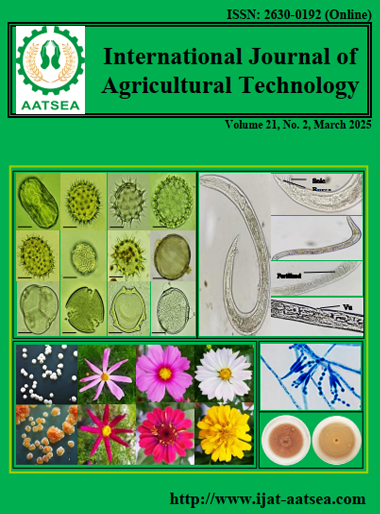Biocontrol potential of Bacillus spp. against bacterial blight and bacterial leaf streak pathogens in rice
Main Article Content
Abstract
Bacterial leaf blight and bacterial leaf streak are major rice diseases caused by Xanthomonas oryzae pv. oryzae (Xoo) and X. oryzae pv. oryzicola (Xoc). In this study, rhizosphere soil samples were collected from healthy rice in Suphanburi, Kanchanaburi, and Surin provinces of Thailand. Among 135 bacterial strains isolated from the soil samples, only six isolates were selected mainly based on their strong antagonistic activity against Xoo. By dual-culture test, isolated strain KRI2 provided the largest Xoo inhibition zone diameters of 30.16 mm, followed by SRN19 and SPB1_1 with diameters of 24.30 mm and 24.06 mm, respectively. The largest Xoc inhibition zone diameter was obtained from strain SRN19 (15.46 mm), followed by strain SPB1_1 (14.21 mm) and strain SPB1_10 (14.00 mm). In addition, all six selected strains were able to inhibit the growth of Curvularia lunata, the rice pathogenic fungus. Morphological characterization revealed that all six strains were Gram-positive bacteria with rod shape. Molecular characterization by 16S rDNA gene sequencing analysis exhibited that all six strains belong to the genus Bacillus. Four isolated strains, SPB1_1, SPB1_10, SRN19, and KRI6, were identified as Bacillus velezensis. KRI2 and KRI4 were identified as Bacillus sonorensis and Bacillus subtilis, respectively. Besides, antagonist-related lytic enzyme production ability and plant growth-promoting traits of the six strains were observed. It was found that all six strains were able to produce protease and cellulase but showed an ability to solubilize phosphate and nitrogen fixation slightly.
Article Details

This work is licensed under a Creative Commons Attribution-NonCommercial-NoDerivatives 4.0 International License.
References
Azizi, M. M. F. and Lau, H. Y. (2022). Advanced diagnostic approaches developed for the global menace of rice diseases: a review, Canadian Journal of Plant Pathology, 44:627-651.
Chaiharn, M., Theantana, T. and Pathom-aree, W. (2020). Evaluation of biocontrol activities of Streptomyces spp. against rice blast disease fungi. Pathogens, 9:126.
Doni, F., Suhaimi, N. S. M., Mispan, M. S., Fathurrahman, F., Marzuki, B. M., Kusmoro, J. and Uphoff, N. (2022). Microbial contributions for rice production: from conventional crop management to the use of ‘omics’ technologies. International Journal of Molecular Sciences, 23:737.
Godon, S. A. and Weber, R. P. (1951). Colorimetric estimation of indole acetic acid. Plant Physiology, 26:192-195.
Jiang, N., Yan, J., Liang, Y., Shi, Y., He, Z., Wu, Y., Zeng, Q., Liu, X. and Peng, J. (2020). Resistance genes and their interactions with bacterial blight/leaf streak pathogens (Xanthomonas oryzae) in rice (Oryza sativa L.)-an updated review. Rice, 13:3.
Jin, P., Wang, Y., Tan, Z., Liu, W. and Miao, W. (2020). Antibacterial activity and rice-induced resistance mediated by C15 surfactin A, in controlling rice disease caused by Xanthomonas oryzae pv. oryzae. Pesticide Biochemistry and Physiology, 169:104669.
Marin, V. R., Ferrarezi, J. H., Vieira, G. and Sass, D. C. (2019). Recent advances in the biocontrol of Xanthomonas spp. World Journal of Microbiology and Biotechnology, 35:72.
Ngammuangtueng, P., Jakrawatana, N., Nilsalab, P. and Gheewala, S. H. (2019). Water, energy and food nexus in rice production in Thailand. Sustainability, 11:5852.
Niño-Liu, D. O., Ronald, P. C and Bogdanove, A. J. (2006). Xanthomonas oryzae pathovars: model pathogens of a model crop. Molecular Plant Pathology, 7:303-324.
Patel, S., Jinal, H. N. and Amaresan, N. (2017). Isolation and characterization of drought resistance bacteria for plant growth promoting properties and their effect on chilli (Capsicum annuum) seedling under salt stress. Biocatalysis and Agricultural Biotechnology, 12:85-89.
Penha, R. O., Vandenberghe, L. P. S., Faulds, C., Soccol, V. T. and Soccol, C. R. (2020). Bacillus lipopeptides as powerful pest control agents for a more sustainable and healthy agriculture: recent studies and innovations. Planta, 251:70.
Prasad, B., Sharma, D., Kumar, P. and Dubey, R. C. (2023). Biocontrol potential of Bacillus spp. for resilient and sustainable agricultural systems. Physiological and Molecular Plant Pathology, 128:102173.
Saechow, S., Thammasittirong, A. and Thammasittirong, S. N. (2016). In vitro inhibitory effect of Bacillus subtilis BAS114 against Curvularia lunata. Advances in Environmental Biology, 10:176-183.
Saiyam, D., Dubey, A., Malla, M. A. and Kumar, A. (2024). Lipopeptides from Bacillus: unveiling biotechnological prospects-sources, properties, and diverse applications. Brazilian Journal of Microbiology, 55:281-295.
Sanya, D. R. A., Syed-ab-rahman, S. F., Jia, A., Onésime, D., Kim, K. M., Ahohuendo, B. C. and Rohr, J. R. (2022). A review of approaches to control bacterial leaf blight in rice. World Journal of Microbiology and Biotechnology, 38:113.
Tan, S., Jiang, Y., Song, S., Huang, J., Ling, N., Xu, Y. and Shen, Q. (2013). Two Bacillus amyloliquefaciens strains isolated using the competitive tomato root enrichment method and their effects on suppressing Ralstonia solanacearum and promoting tomato plant growth. Crop Protection, 43:134-140.
Thamkhongdee, A., Chinachanta, W., Chromkaew, Y., Chaiwan, F. and Shutsrirung, A. (2019). Abilities of nitrogen fixing bacteria in enhancing growth of arabica coffee seedling. Journal of Agriculture, 36:79-91.
Wu, L., Wu, H., Chen, L., Yu, X., Borriss, R. and Gao, X. (2015). Difficidin and bacilysin from Bacillus amyloliquefaciens FZB42 have antibacterial activity against Xanthomonas oryzae rice pathogens. Scientific Reports, 5:12975.
Zhou, J., Xie, Y., Liao, Y., Li, X., Li, Y., Li, S., Ma, X., Lei, S., Lin, F., Jiang, W. and He, Y-Q. (2022). Characterization of a Bacillus velezensis strain isolated from Bolbostemmatis Rhizoma displaying strong antagonistic activities against a variety of rice pathogens. Frontiers in Microbiology, 13:983781.


